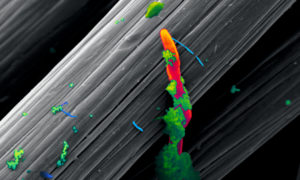
Scientists use carbon-fiber electrodes (gray) to lure electricity-eating microbes (orange). These microbes grow incredibly slowly, so attracting them can take time. Researchers left this electrode underground for five months.
Credit: Yamini Jangir and Moh El-Naggar
Last year, biophysicist Moh El-Naggar and his graduate student Yamini Jangir plunged beneath South Dakota’s Black Hills into an old gold mine that is now more famous as a home to a dark matter detector. Unlike most scientists who make pilgrimages to the Black Hills these days, El-Naggar and Jangir weren’t there to hunt for subatomic particles. They came in search of life.
In the darkness found a mile underground, the pair traversed the mine’s network of passages in search of a rusty metal pipe. They siphoned some of the pipe’s ancient water, directed it into a vessel, and inserted a variety of electrodes. […]










